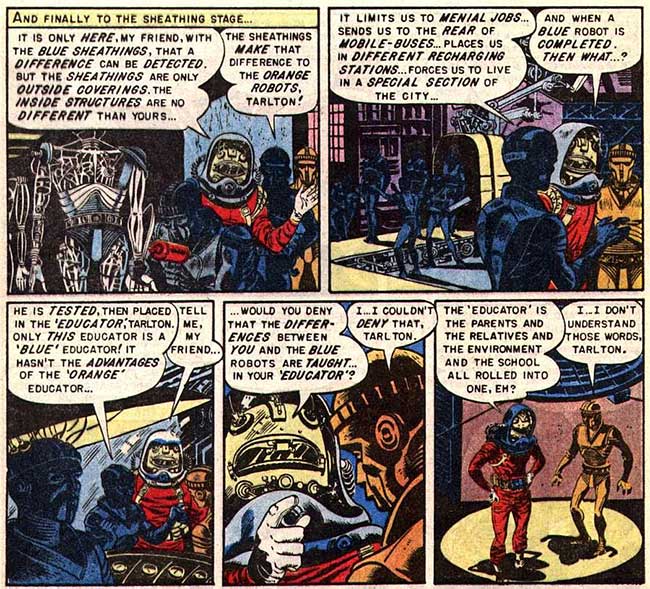They were known as EC: Entertaining Comics, but that didn’t mean that they didn’t have important things to say. Your Major Spoilers (Retro) Review of Weird Fantasy #18 awaits!
 WEIRD FANTASY #18
WEIRD FANTASY #18
Writer: Bill Gaines/Al Feldstein/Ray Bradbury
Penciler: John Severin/Jack Kamen/Al Williamson/Roy Krenkel/Joe Orlando
Inker: Bill Elder/Jack Kamen/Al Williamson/Roy Krenkel
Colorist: Marie Severin/Joe Orlando
Letterer: Jim Wroten
Editor: Roy Thomas
Publisher: EC Comics
Cover Price: 10 Cents
Current Near-Mint Pricing: $260.00
Previously in Weird Fantasy: When EC Comics was established circa 1944, it’s mission was to educate young folks on matter of science, history and Biblical text. It’s founder, Max Gaines, left All-American Publications (one of the companies that would become modern DC), only to lose his life in an accident, leaving EC in the hands of his son Bill. Under the younger Gaines editorial reigns, EC expanded into science fiction, suspense, crime and horror comics, as well as launching Mad Magazine, the gold standard of humor magazines. Thanks to a truly talented stable of creators, EC Comics stood out from the crowd, with twist endings becoming an EC trademark and this issue is repeatedly pointed out as one of the biggest twists of them all. There are actually five separate stories in Weird Fantasy #18: ‘Counter-Clockwise,’ a science fiction piece with a time travel shock ending, ‘Zero Hour,’ a not-quite-as-scary-as-it-could-be ghostly tale from Ray Bradbury; The Ashtray, a science fiction snippet, and a truly cruel space tragedy called ‘Homesick!‘ It’s a strong line-up, but we’re here for the final tale, an example of the kind of story EC creative called “a preachy.”

If you know anything about EC Comics, you probably know this story. It’s The Future™, year unknown, and an astronaut called Tarlton has arrived to survey a new colony and assess whether or not they’re ready to join the civilizations of the galaxy. This particular world is unique, populated entirely by automatons, originally built by Earthlings, who have now created their own civilization. The robot envoy proudly shows him around their world, pointing out all of their development in the fields of technology and governance.

When asked about blue robots, though, the orange representative seems hesitant, evading the question as he once again points out the efficiency and precision of their world. Once a robot is completed, he explains, it will work on the assembly lines for a while and then is free to choose their own thing in which to specialize.

I really enjoy Joe Orlando’s work in creating the visuals of Cybrinian society, making it clear that this is a weird science fiction world, but it’s also intentionally and clearly an analogue of the mid-20th cnetury United States. The ominous statement about “keeping them in their place” makes it clear that the parallels aren’t just in the technology or architecture, either. Tarlton witnesses the hierarchy of robots in action, eventually making his way to Blue Town, where they assess the factory where the blue-shells are made, only to find that their designs, their alloys, their very mechanisms are identical to those of the oranges. His host admits that this is all information that he is aware of, explaining how blues actually differ.

It’s clear that Tarlton knows his history, but the robot doesn’t see the point of all the questions. After all, it’s just the way his society works. It’s not as if he, personally, designed the broken system or chooses to make the blue robots live differently…

…and then, that twist ending. In the year 2020, it might be hard to fathom how strong an anti-racist statement ‘Judgment Day’ is making with the reveal of Tarlton’s ethnicity and how his society has gone beyond prejudice, but in the fifties, the Comics Code Authority insisted that this story could not be printed. Representatives of the CCA insisted that the character COULD NOT be Black, but writer Feldstein and Max Gaines refused to make the change, reputedly throwing an F-bomb at the requesting CCA judge. (Weirdly, after it became clear the creators weren’t changing Tarlton’s skin color, the CCA insisted that the perspiration on his skin be removed, a request that EC also ignored.)
What’s even weirder? That argument came not over this issue, but over a reprint of this story in another book, THREE YEARS AFTER it ran here. That book ended up being the last EC Comic ever published, in part because of that conflict. On the one hand, that final panel reveal doesn’t carry the same sense of shock that it did in ’53 or in ’56, but the power that it still carries should serve as a reminder that there is still anti-racist work to be done, even in the worlds of fiction. In short, Weird Fantasy #18 is not only a shining example of how comics have always been political, but contains a really good story that shows how powerful a single moment of storytelling can be, earning 4 out of 5 stars overall. Sometimes, it can feel like nothing ever changes for the better, but the fact that ‘Judgment Day,’ with its well-done art and skillful twist ending, feels like less of a big deal in 2020 is proof that it’s possible to use our fictions to examine contemporary issues, and perhaps be part of a larger change.
Dear Spoilerite,
At Major Spoilers, we strive to create original content that you find interesting and entertaining. Producing, writing, recording, editing, and researching requires significant resources. We pay writers, podcast hosts, and other staff members who work tirelessly to provide you with insights into the comic book, gaming, and pop culture industries. Help us keep MajorSpoilers.com strong. Become a Patron (and our superhero) today.
WEIRD FANTASY #18
A couple of solid science fiction stories, a Ray Bradbury chiller and a moment that still resonates powerfully sixty years later makes for one heck of a read.
-
Writing8
-
Art8
-
Coloring7


